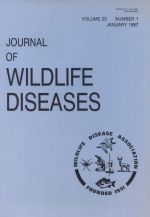Mouse-lethal toxin identified as that of Clostridium botulinum type C by antitoxin neutralization was present in cultures of 38.0% of 326 soil samples collected from 28 wetlands in Saskatchewan. There was no difference in prevalence of toxicity between samples collected in spring and summer, and no relationship was evident between the occurrence of toxicity and water salinity, marsh type or water depth. There was a strong association between the prior occurrence of avian botulism in a marsh and the presence of toxin in cultures from soil; 59.2% of soil samples from marshes with a known history of botulism produced toxin, whereas only 6.2% of soil samples from marshes with no history of the disease produced toxin. Eight of the 10 soil samples collected from a marsh that had been dry for several years, and from another marsh that had not had a recognized outbreak of botulism for 11 yr produced toxin, indicating a long residual effect after a botulism outbreak. The results suggest that any wetland with a history of botulism is likely to suffer repeated occurrences because of heavy contamination of the soil with spores, and should be managed to control the disease.
How to translate text using browser tools
1 January 1987
OCCURRENCE OF TOXIGENIC CLOSTRIDIUM BOTULINUM TYPE C IN THE SOIL OF WETLANDS IN SASKATCHEWAN
G. Wobeser,
S. Marsden,
R. J. MacFarlane





